Regions
Texel Mountains, Sarntal Alps, Ortler Range, Southern Stubai Alps, Ulten Valley
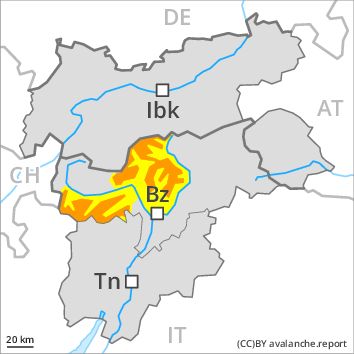
Danger level
Danger Level 3 - Considerable above 2200m
Danger Level 2 - Moderate above 2200m
Avalanche Problem
Wind-drifted snow above 2200m, N-NE-E-SE-S-SW-W-NW

Wind slabs require caution.
As a consequence of fresh snow and a strong to storm force southwesterly wind, sometimes easily released wind slabs formed in particular at intermediate and high altitudes. The wind has transported the old snow. In particular transitions from a shallow to a deep snowpack are dangerous. The number and size of avalanche prone locations will increase with altitude. Remotely triggered and natural avalanches are possible in isolated cases. Snow sport activities outside marked and open pistes call for meticulous route selection. The avalanche prone locations are prevalent and are barely recognisable because of the poor visibility. The wind slabs represent the main danger. As the penetration by moisture increases more small and medium-sized gliding avalanches are possible below approximately 2400 m.
Snowpack
The fresh and older wind slabs remain for the foreseeable future prone to triggering in all aspects above approximately 2000 m. As a consequence of the southerly wind the wind slabs will increase in size additionally. They are lying on soft layers. On wind-loaded slopes a precarious avalanche situation will be encountered over a wide area. The wind will be storm force.
Tendency
The snow sport conditions outside marked and open pistes are precarious.
Regions
Val Müstair Alps, Langtaufers
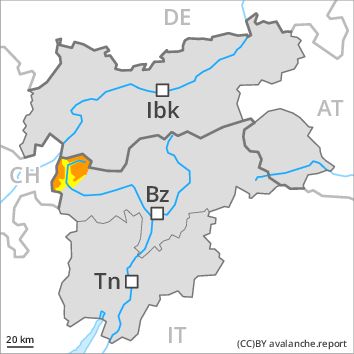
Danger level
Danger Level 3 - Considerable above the treeline
Danger Level 2 - Moderate above the treeline
Avalanche Problem
Wind-drifted snow above 2200m, N-NE-E-SE-NW
Persistent weak layer, N-NE-E-SE-S-SW-W-NW

Wind slabs and weakly bonded old snow require caution.
Faceted weak layers exist in the bottom section of the old snowpack here. As a consequence of a strong to storm force wind, sometimes easily released wind slabs formed in the last few days in particular above the tree line. In particular transitions from a shallow to a deep snowpack are dangerous. Remotely triggered and natural avalanches are possible in isolated cases. Snow sport activities outside marked and open pistes call for meticulous route selection. The avalanche prone locations are prevalent and are barely recognisable because of the poor visibility.
Snowpack
The fresh and older wind slabs remain prone to triggering in particular on northeast to north to southeast facing aspects above approximately 2200 m. They are lying on soft layers. As a consequence of the southerly wind the wind slabs will increase in size additionally. The wind was storm force. On wind-loaded slopes a precarious avalanche situation will be encountered over a wide area.
Tendency
Regions
Prealps, Cembra Valley, Bondone and Stivo, Vallarsa, Folgaria - Laverone, Ledro Valley, Paganella, Marzola - Valsugana, Pine' - Mocheni Valley
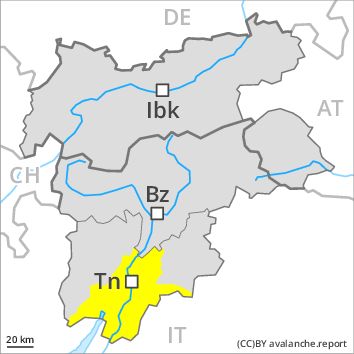
Danger level
Danger Level 2 - Moderate above the treeline
Danger Level 2 - Moderate above the treeline
Avalanche Problem
Wind-drifted snow above the treeline, N-NE-E-SE-S-SW-W-NW
Gliding snow above the treeline, N-NE-E-SE-S-SW-W-NW

Wind slabs above approximately 1800 m. Below approximately 1800 m the snow is wet.
The mostly small wind slabs can be released even by a single winter sport participant. They are to be found in particular adjacent to ridgelines and generally in the high Alpine regions. Below approximately 1800 m mostly small natural loose snow slides are possible.
Snowpack
The mostly small wind slabs represent the main danger. They are to be evaluated with care and prudence in particular on steep shady slopes above approximately 1800 m. Below approximately 1800 m the snow is wet.
Tendency
The avalanche danger will persist.
Regions
Sexten Dolomites, Eastern Pfunderer Mountains, Durreck Range, Western Rieserferner Mountains, Western Deferegger Alps, Schnals Ridge, Northern Zillertal Alps, Venediger Range, Southern Zillertal Alps and High Tauern, Eastern Nonsberger Alps, Eastern Rieserferner Mountains, Northern Dolomites of Fiemme, Saldurn-Mastaun Ridge, Glockner Range, Gröden Dolomites, Eastern Deferegger Alps, Prags Dolomites, Schober Mountains, Western Pfunderer Mountains, Lienzer Dolomites
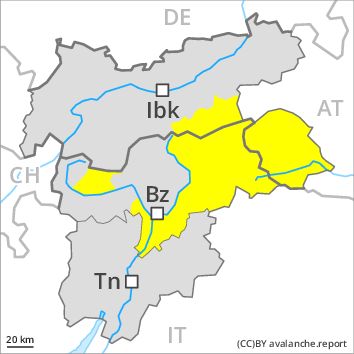
Danger level
Danger Level 2 - Moderate
Avalanche Problem
Wind-drifted snow above 2200m, N-NE-E-NW
Gliding snow above 2600m, E-SE-S-SW-W

Wind slabs represent the main danger. Gliding avalanches can also occur.
The wind slabs of the last few days represent the main danger. These can be released, especially by large additional loads, in particular on northwest to north to east facing aspects above approximately 2200 m. As a consequence of a strong southerly wind, further wind slabs will form in particular in high Alpine regions. They are barely recognisable because of the poor visibility.
Weak layers in the upper part of the snowpack can still be released in very isolated cases on very steep sunny slopes, especially above approximately 2500 m. Avalanches are rather small. These avalanche prone locations are barely recognisable, even to the trained eye.
As the moisture increases there will be an increase in the danger of gliding avalanches and moist snow slides. Snow sport activities outside marked and open pistes call for experience in the assessment of avalanche danger and a certain restraint.
Snowpack
dp 6: cold, loose snow and wind
dp 2: gliding snow
The fresh and older wind slabs are lying on soft layers in particular on shady slopes at high altitude. Faceted weak layers exist in the top section of the old snowpack on steep sunny slopes. These can in very isolated cases be released, in particular by large loads. At low and intermediate altitudes the snow is moist, also on sunny slopes below approximately 2600 m.
Tendency
The avalanche danger will persist.
Regions
Western Lechtal Alps, Allgäu Alps
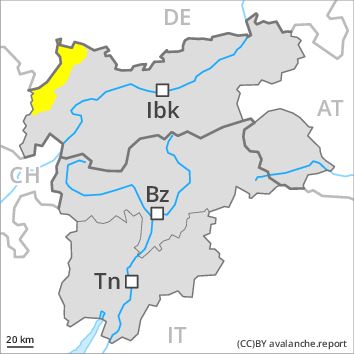
Danger level
Danger Level 2 - Moderate
Avalanche Problem
Wind-drifted snow above 2200m, N-NE-E-NW
Gliding snow above 2600m, E-SE-S-SW-W

Wind slabs represent the main danger. Gliding avalanches can also occur.
The wind slabs of the last few days represent the main danger. These can be released, especially by large additional loads, in particular on northwest to north to east facing aspects above approximately 2200 m. As a consequence of a strong southerly foehn wind, further wind slabs will form in particular in high Alpine regions. They are clearly recognisable to the trained eye.
Weak layers in the upper part of the snowpack can still be released in very isolated cases on very steep sunny slopes, especially above approximately 2500 m. Avalanches are rather small. These avalanche prone locations are barely recognisable, even to the trained eye.
As a consequence of warming there will be an increase in the danger of gliding avalanches and moist snow slides. Snow sport activities outside marked and open pistes call for experience in the assessment of avalanche danger and a certain restraint.
Snowpack
dp 6: cold, loose snow and wind
dp 2: gliding snow
The fresh and older wind slabs are lying on soft layers in particular on shady slopes at high altitude. These have bonded quite well with the old snowpack. Faceted weak layers exist in the top section of the old snowpack on steep sunny slopes. These can in very isolated cases be released, in particular by large loads. At low and intermediate altitudes the snow is moist, also on sunny slopes below approximately 2600 m.
Tendency
The avalanche danger will persist.
Regions
Southern Adamello, Primiero - Pale di S. Martino, Adamello - Presanella, Northern Brenta - Peller, Western Nonsberg Alps, Southern Brenta, Fassa Valley, Sole, Pejo and Rabbi, Southern Lagorai, Northern Lagorai, Latemar, Maddalene
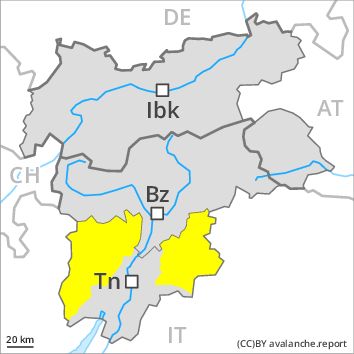
Danger level
Danger Level 2 - Moderate
Avalanche Problem
Wind-drifted snow above the treeline, N-NE-E-SE-S-SW-W-NW
Gliding snow above 2400m, N-NE-E-SE-S-SW-W-NW

Fresh wind slabs require caution.
As a consequence of a strong to storm force wind, sometimes deep wind slabs formed in particular adjacent to ridgelines and in gullies and bowls. The avalanche prone locations are to be found in all aspects above approximately 2000 m. The wind slabs represent the main danger. Mostly avalanches are medium-sized. The number and size of avalanche prone locations will increase with altitude. Snow sport activities outside marked and open pistes call for meticulous route selection. The avalanche prone locations are prevalent and are barely recognisable because of the poor visibility. As the penetration by moisture increases more small and medium-sized gliding avalanches are possible below approximately 2400 m.
Snowpack
The wind will be strong to storm force. The fresh and older wind slabs remain for the foreseeable future prone to triggering in all aspects above approximately 2000 m. They are lying on soft layers.
Tendency
The avalanche danger will persist.
Regions
Weißkugel Range, Western Verwall Mountains, Gurgler Range, Central Stubai Alps, Eastern Verwall Mountains, Silvretta, Samnaun Mountains, Eastern Lechtal Alps - Ammergau Alps, Northern Oetz and Stubai Alps, Mieming Mountains, Western Tuxer Alps, Karwendel Mountains, Eastern Tuxer Alps, Western Kitzbühel Alps, Central Lechtal Alps, Glockturm Range, Grieskogel Mountains

Danger level
Danger Level 2 - Moderate above 2200m
Danger Level 1 - Low above 2200m
Avalanche Problem
Wind-drifted snow above 2200m, N-NE-E-NW

Wind slabs represent the main danger.
The wind slabs of the last few days represent the main danger. These can be released, especially by large additional loads, in particular on northwest to north to east facing aspects above approximately 2200 m. As a consequence of a strong southerly foehn wind, further wind slabs will form in particular in high Alpine regions. They are clearly recognisable to the trained eye.
As a consequence of warming there will be an increase in the danger of moist snow slides. Snow sport activities outside marked and open pistes call for experience in the assessment of avalanche danger and a certain restraint.
Snowpack
dp 6: cold, loose snow and wind
The fresh and older wind slabs are lying on soft layers in particular on shady slopes at high altitude. These have bonded quite well with the old snowpack. At low and intermediate altitudes the snow is moist, also on sunny slopes below approximately 2600 m.
Tendency
The avalanche danger will persist.
Regions
Brandenberg Alps, Wilder Kaiser Mountains - Waidring Alps, Eastern Kitzbühel Alps
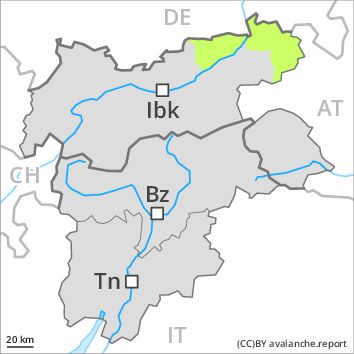
Danger level
Danger Level 1 - Low
Avalanche Problem
Wind-drifted snow above 2200m, N-NE-NW

Wind slabs require caution.
As a consequence of a strong to storm force wind, sometimes avalanche prone wind slabs formed at high altitude. The avalanche prone locations are to be found adjacent to ridgelines and in gullies and bowls, and behind abrupt changes in the terrain. Such avalanche prone locations are rare and are clearly recognisable to the trained eye.
Snowpack
dp 6: cold, loose snow and wind
The fresh and older wind slabs are lying on soft layers on shady slopes at high altitude. These have bonded quite well with the old snowpack. The snowpack will be moist at low and intermediate altitudes. Thus far only a little snow is lying.
Tendency
The avalanche danger will persist.








